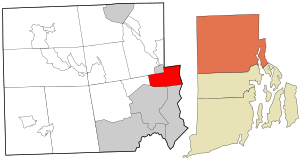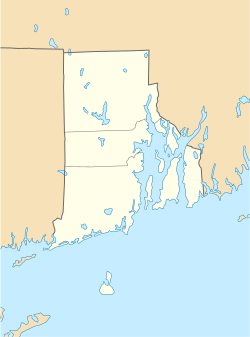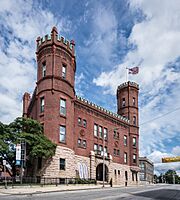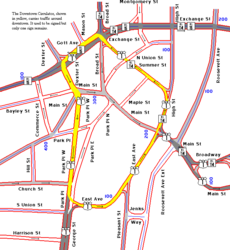Pawtucket, Rhode Island facts for kids
Quick facts for kids
Pawtucket
|
|||||
|---|---|---|---|---|---|
|
City
|
|||||
| City of Pawtucket | |||||
|
Pawtucket City Hall, the Pawtucket Post Office, Jenckes Spinning Company, and Slater Mill
|
|||||
|
|||||
| Motto(s):
Join The Evolution
|
|||||

Location within Providence County and the state of Rhode Island
|
|||||
| Country | |||||
| State | |||||
| County | Providence | ||||
| Founded (town) | 1671 | ||||
| Incorporated (city) | 1886 | ||||
| Government | |||||
| • Type | Mayor-council | ||||
| Area | |||||
| • Total | 8.96 sq mi (23.22 km2) | ||||
| • Land | 8.67 sq mi (22.45 km2) | ||||
| • Water | 0.30 sq mi (0.77 km2) | ||||
| Elevation | 39 ft (12 m) | ||||
| Population
(2020)
|
|||||
| • Total | 75,604 | ||||
| • Density | 8,723.20/sq mi (3,367.98/km2) | ||||
| Time zone | UTC−5 | ||||
| • Summer (DST) | UTC−4 (Eastern) | ||||
| ZIP Codes |
02860–02861
|
||||
| Area code(s) | 401 | ||||
| FIPS code | 44-54640 | ||||
| GNIS feature ID | 1218926 | ||||
Pawtucket (![]() i/pəˈtʌkɪt/ puh-TUK-it) is a city in Providence County, Rhode Island, United States. The population was 75,604 at the 2020 census, making the city the fourth-largest in the state. Pawtucket borders Providence and East Providence to the south, Central Falls and Lincoln to the north, and North Providence to the west. The city also borders the Massachusetts municipalities of Seekonk and Attleboro.
i/pəˈtʌkɪt/ puh-TUK-it) is a city in Providence County, Rhode Island, United States. The population was 75,604 at the 2020 census, making the city the fourth-largest in the state. Pawtucket borders Providence and East Providence to the south, Central Falls and Lincoln to the north, and North Providence to the west. The city also borders the Massachusetts municipalities of Seekonk and Attleboro.
Pawtucket was an early and important center of textile manufacturing. It is home to Slater Mill, a historic textile mill recognized for helping to found the Industrial Revolution in the United States.
Contents
History
The name "Pawtucket" comes from the Algonquian word for "river fall."
The Pawtucket region was said to have been one of the most populous places in New England prior to the arrival of European settlers. American Indians would catch the salmon and smaller fish that gathered at the falls. The first settler here was Joseph Jenckes Jr. who came to the region from Lynn, Massachusetts. He purchased about 60 acres near Pawtucket Falls in 1671, then established a sawmill and forge. The entire town was destroyed during King Philip's War.
Other settlers followed Jenks, and the area became home to manufacturers of muskets, linseed oil, potash, and ships by 1775. Also around this time, Oziel Wilkinson and his family set up an iron forge that made anchors, nails, screws, farm implements, and cannons.
By the 1920s, Pawtucket was a prosperous mill town. The city had a half-dozen movie theaters, two dozen hotels, and an impressive collection of fine commercial and residential architecture. Perhaps the most impressive public building in Pawtucket was the Leroy Theatre, an ornate movie palace that was called "Pawtucket's Million Dollar Theater". Many wealthy mill owners such as Darius Goff built their mansions in the area.
In 1922, it was affected by the 1922 New England Textile Strike, shutting down the mills in the city over an attempted wage cut and hours increase.
The textile business in New England declined during the Great Depression, with many manufacturers closing or moving their facilities to the South where operations and labor were cheaper. Later in the 20th century, Pawtucket began to lose some of its architectural heritage to the wrecking ball, including the Leroy Theatre.
Pawtucket retained much of its industrial base, however. Today, goods produced in the city include lace, non-woven and elastic woven materials, jewelry, silverware, metals, and textiles. Hasbro, one of the world's largest manufacturers of toys and games, is headquartered in Pawtucket.
Incorporation
Originally, the land west of the Blackstone River was part of nearby North Providence, and east of the Blackstone River was originally settled as part of Rehoboth, Massachusetts. The first Pawtucket to be incorporated was when Rehoboth gave up their land in 1828, and Pawtucket became a new town in Massachusetts. In 1862, the eastern portion was absorbed into Providence County, Rhode Island. On March 1, 1862, the area of Pawtucket and East Providence was shifted into Rhode Island, and the new border remains to this day—following a 225-year border dispute among the Rhode Island Colony, Plymouth Colony, the State of Rhode Island, and the Commonwealth of Massachusetts. In 1874, the land west of the river was taken from North Providence and added to the town of Pawtucket, but it acted as two different towns. Finally in 1886, West and East Pawtucket were merged and the city was incorporated.
Geography
According to the United States Census Bureau, the city has a total area of 9.0 square miles (23 km2), of which 8.7 square miles (23 km2) is land and 0.3 square miles (0.78 km2) (2.89%) is water. Pawtucket lies within three drainage basins. These include the Blackstone River (including the Seekonk River), the Moshassuck River and the Ten Mile River.
Demographics
| Historical population | |||
|---|---|---|---|
| Census | Pop. | %± | |
| 1830 | 1,459 | — | |
| 1840 | 2,184 | 49.7% | |
| 1850 | 3,753 | 71.8% | |
| 1860 | 4,200 | 11.9% | |
| 1870 | 6,619 | 57.6% | |
| 1880 | 19,030 | 187.5% | |
| 1890 | 27,633 | 45.2% | |
| 1900 | 39,231 | 42.0% | |
| 1910 | 51,622 | 31.6% | |
| 1920 | 64,248 | 24.5% | |
| 1930 | 77,149 | 20.1% | |
| 1940 | 75,797 | −1.8% | |
| 1950 | 81,436 | 7.4% | |
| 1960 | 81,001 | −0.5% | |
| 1970 | 76,984 | −5.0% | |
| 1980 | 71,204 | −7.5% | |
| 1990 | 72,644 | 2.0% | |
| 2000 | 72,958 | 0.4% | |
| 2010 | 71,148 | −2.5% | |
| 2020 | 75,604 | 6.3% | |
| U.S. Decennial Census | |||
2020 census
The 2020 United States census counted 75,604 people, 31,565 households, and 17,202 families in Pawtucket. The population density was 8,723.2 per square mile (3,368.0/km2). There were 33,832 housing units at an average density of 3,903.5 per square mile (1,507.2/km2). The racial makeup was 49.59% (37,492) white or European American (45.54% non-Hispanic white), 13.01% (9,836) black or African-American, 0.63% (475) Native American or Alaska Native, 1.51% (1,140) Asian, 0.08% (57) Pacific Islander or Native Hawaiian, 16.44% (12,429) from other races, and 18.75% (14,175) from two or more races. Hispanic or Latino of any race was 24.77% (18,727) of the population.
Of the 31,565 households, 29.4% had children under the age of 18; 32.4% were married couples living together; 34.8% had a female householder with no spouse or partner present. 33.5% of households consisted of individuals and 11.3% had someone living alone who was 65 years of age or older. The average household size was 2.6 and the average family size was 3.2. The percent of those with a bachelor's degree or higher was estimated to be 16.3% of the population.
21.8% of the population was under the age of 18, 8.4% from 18 to 24, 29.4% from 25 to 44, 26.2% from 45 to 64, and 14.3% who were 65 years of age or older. The median age was 37.7 years. For every 100 females, the population had 107.4 males. For every 100 females ages 18 and older, there were 110.6 males.
The 2016-2020 5-year American Community Survey estimates show that the median household income was $52,902 (with a margin of error of +/- $3,574) and the median family income was $66,544 (+/- $2,789). Males had a median income of $39,641 (+/- $1,932) versus $31,646 (+/- $1,286) for females. The median income for those above 16 years old was $35,243 (+/- $1,022). Approximately, 11.4% of families and 14.1% of the population were below the poverty line, including 20.1% of those under the age of 18 and 14.4% of those ages 65 or over.
2010 census
As of the census of 2010, there were 71,141 people, 32,055 households, and 18,508 families residing in the city. Pawtucket was the fourth most populous of Rhode Island's 39 cities and towns. The population density was 8,351.2 inhabitants per square mile (3,224.4/km2). There were 32,055 housing units at an average density of 3,642.2 per square mile (1,406.3/km2). The racial makeup of the city was 50.4% Non-Hispanic white, 18.9% Non-Hispanic African American, 0.6% Native American, 1.6% Non-Hispanic Asian, 0.1% Pacific Islander, mixed race 3.9%, 4.7% other. About 25% of residents are Latino.
There were 32,055 households, out of which 30.5% had children under the age of 18 living with them, 39.7% were married couples living together, 16.8% had a female householder with no husband present, and 38.4% were non-families. Of all households, 32.3% were made up of individuals, and 12.5% had someone living alone who was 65 years of age or older. The average household size was 2.41 and the average family size was 3.07.
In the city, the population was spread out, with 24.9% under the age of 18, 9.1% from 18 to 24, 31.3% from 25 to 44, 19.9% from 45 to 64, and 14.8% who were 65 years of age or older. The median age was 35 years. For every 100 females, there were 90.2 males. For every 100 females age 18 and over, there were 85.9 males.
The median income for a household in the city was $28,124, and the median income for a family was $40,578. Males had a median income of $31,129 versus $23,391 for females. The per capita income for the city was $17,008. About 14.9% of families and 16.8% of the population were below the poverty line, including 24.5% of those under age 18 and 15.2% of those age 65 or over.
Economy
Hasbro, a Fortune 1000 toy and game making company, is headquartered in Pawtucket.
Many healthcare, retail and insurance companies are headquartered in Pawtucket.
Fox Point Pickles, a pickling company, is headquartered in Pawtucket.
Arts and culture
The City of Pawtucket has been supportive of the arts community since 1975. On September 2, 1977, the Beach Boys performed a concert at Narragansett Park attended by 40,000 people, the largest concert audience in Rhode Island history. In 2017, music historians Al Gomes and Connie Watrous of Big Noise were successful in getting the street where the concert stage stood (the corner of 511 Narragansett Park Drive) officially renamed as "Beach Boys Way".
In January 1999, Herb Weiss, of the Planning Department, was hired to oversee the city's newly created Arts District. Through the support of then Mayor James E. Doyle and Planning Department Michael Cassidy, Weiss brought significant recognition for Pawtucket-Arts oriented development strategy. Mayor Doyle and Weiss hired researcher Ann Galligan, of Northeastern University, to create an arts and cultural plan. Over the years Pawtucket has become a center for arts and culture.
Several experimental/indie rock bands have recorded albums at Machines with Magnets, a recording studio and art gallery in Downtown Pawtucket. Bands that have performed or recorded here include Battles, Lightning Bolt, Brown Bird, and Fang Island.
One hub for arts and culture in the city is Lorraine Mills, a repurposed mill building on the eastern side of the city, which houses institutions including Mixed Magic Theatre, Wage House (comedy club), Pawtucket Arts Collaborative, and Crooked Current Brewery.
Each September, the city, in conjunction with the Pawtucket Arts Festival Board of Directors, members chosen from the community, produce an annual citywide Arts Festival.
Pawtucket is home to McCoy Stadium, where the Pawtucket Red Sox, the Triple-A Minor League Baseball affiliate of the Boston Red Sox, played from 1970 to 2020. The team was owned by Ben Mondor until his death and was sold by his estate. The longest professional baseball game in history, 33 innings, was played at McCoy Stadium in 1981. Pawtucket has a history of professional baseball dating back to 1892, including the Pawtucket Maroons and Pawtucket Indians. The PawSox franchise was relocated to Worcester, Massachusetts, to become the Worcester Red Sox beginning with the 2021 season.
In 2024, Rhode Island FC, of the USL Championship, will have its inaugural season. Starting in 2025, the team will play at a soccer-specific stadium along the Seekonk River. The team is headquartered in Pawtucket.
In 1934, the Narragansett Park opened for Thoroughbred horse racing. Until its closure in 1978, the track hosted several important races that drew some of the top horses from around the United States including Hall of Fame members; Seabiscuit, War Admiral and Gun Bow.
-
The Portuguese Social Club of Pawtucket marches in the 2021 Bristol Fourth of July Parade
Parks and recreation
- Slater Memorial Park has full recreational facilities including tennis courts and picnic areas.
- Daggett Farm
- Water Color Gallery open to the public for viewing
- Daggett House
- Marconi Garden
Education
Public schools
Public education in Pawtucket is directed by the Pawtucket School Department and contains these schools:
Senior high schools
- Charles E. Shea
- William E. Tolman
- Blackstone Academy Charter School
- Jacqueline M Walsh School for the Arts
Middle schools
- Joseph Jenks
- Samuel Slater
- Lyman B. Goff
Elementary schools
- Elizabeth Baldwin
- M. Virginia Cunningham
- Flora S. Curtis
- Curvin McCabe
- Fallon Memorial
- Nathanael Greene
- Agnes E. Little
- Potter Burns
- Francis J. Varieur
- Henry J. Winters
Catholic schools
The Quality Hill section of Pawtucket is home to St. Raphael Academy. It is a private college preparatory school founded on the basis of St. John the Baptist de la Salle. "Saints" is a small school consisting of roughly 500 students with a student to teacher ratio of about 15:2. The "Saints and Lady Saints" are very successful in sports including baseball, football, basketball, and softball. St. Raphael Academy is a rival of William E. Tolman. The two schools took part in a Thanksgiving Day football game that was played in McCoy Stadium for over 70 years, though game is no longer played. William E. Tolman now competes annually against its fellow Pawtucket public high school Charles E. Shea, rather than against St. Raphael Academy, a private Catholic high school.
Pawtucket was home to Bishop Keough High School, a small all-girls Catholic high school in the Fairlawn neighborhood.
The city also has three Catholic elementary schools: St. Cecilia School, St. Teresa School and Woodlawn Catholic Regional School.
Infrastructure
Transportation
Pawtucket is served by several RIPTA local bus routes plus the R-Line. Pawtucket/Central Falls station on the MBTA Commuter Rail Providence/Stoughton Line opened on January 23, 2023, replacing the former station that closed in 1981.
Highways and roads
Interstate 95 and U.S. 1 also traverse the western part of Pawtucket. Some of the slowest posted speeds on I-95 are in the city due to the "S-curves" near downtown. To preserve certain buildings in the city, planners snaked I-95, creating sharp bends in the highway.
Downtown Circulator
Pawtucket's Downtown Circulator was a one-way loop through downtown; it is similar to British concepts of ring roads. A similar concept was also tried in Providence.
The circulator used East Avenue, High Street, Summer Street, Goff Avenue, Dexter Street and Park Place West. Each half of the Circulator carried one direction of U.S. 1; sections also carried westbound RI 15 and northbound RI 114. It was signed with a big "C" on overhead signs.
There are no longer signs for the circulator, though the road configuration remains. Providence's Downtown Ring Roads have suffered a similar fate.
Notable people
Sister town
- Belper, Derbyshire, England, Belper was where Samuel Slater had been apprenticed to Jedediah Strutt, learning the secrets of Richard Arkwright's Water Frame. He is sometimes known in that area as "Slater the traitor". Belper holds an annual town festival in honor of Pawtucket and Belper being sister towns.
See also
 In Spanish: Pawtucket para niños
In Spanish: Pawtucket para niños




















